Project Risk Analysis: Jacobs Engineering Group Construction Report
VerifiedAdded on 2022/12/27
|23
|4386
|66
Report
AI Summary
This report provides a comprehensive analysis of project risk management within the construction industry, using Jacobs Engineering Group as a case study. It explores the importance of risk management, particularly within the context of the construction sector, and delves into the strategies employed by Jacobs to identify, assess, and mitigate risks. The report examines the company's approach to risk management, including the use of various tools and techniques, such as cost-effective plans, and the categorization of risks into asset, project and program, operations, and corporate risks. Furthermore, it discusses the role of procurement management, highlighting the importance of collaboration with suppliers and subcontractors, the use of different contract types, and the implementation of quality monitoring and control measures. The report also investigates the application of risk management theories and models, such as decision-making theory and contingency theory, to enhance the effectiveness of risk management strategies. Through this analysis, the report offers insights into how appropriate practices can assist in minimizing risk for construction projects and achieving sustainable development.
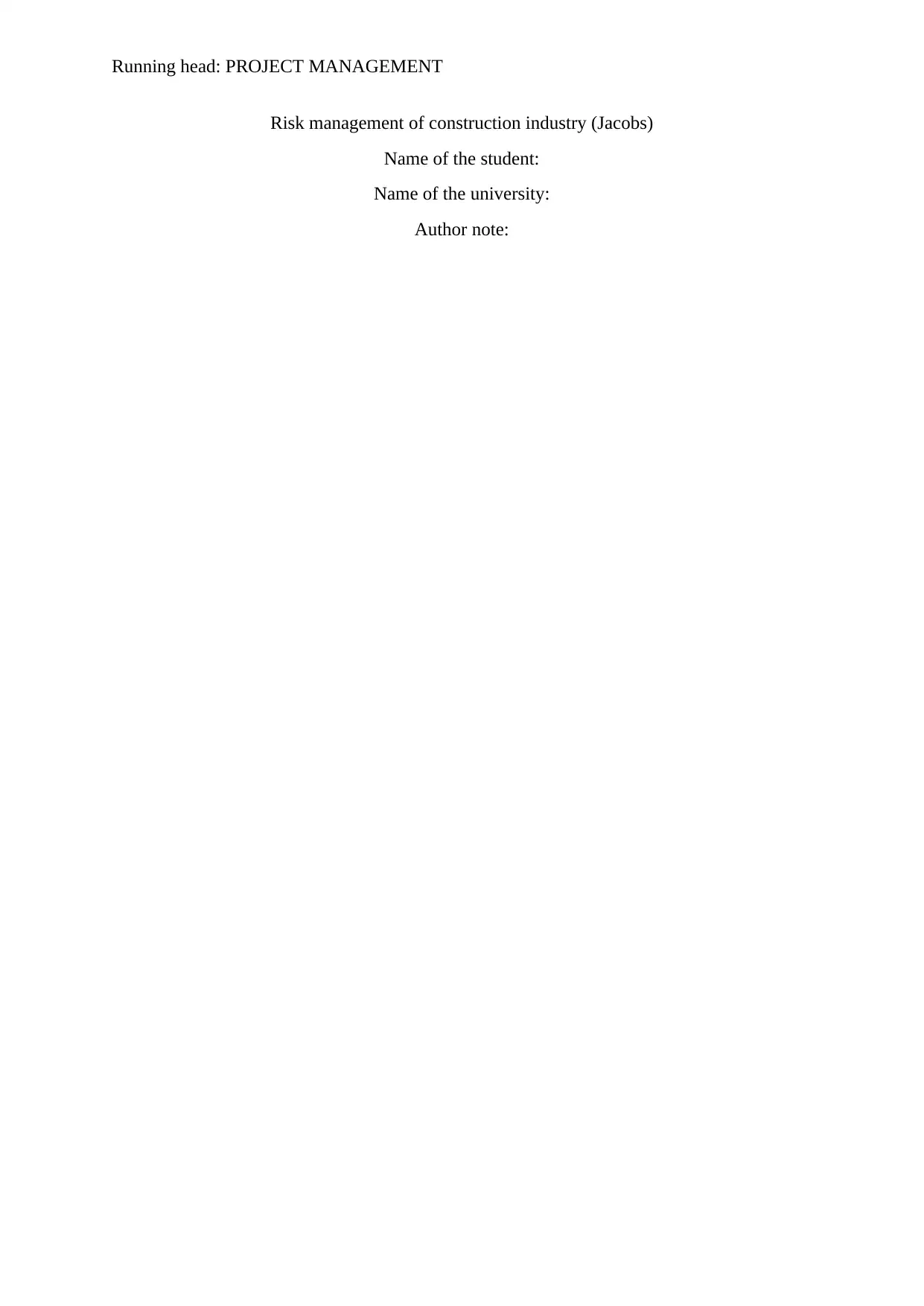
Running head: PROJECT MANAGEMENT
Risk management of construction industry (Jacobs)
Name of the student:
Name of the university:
Author note:
Risk management of construction industry (Jacobs)
Name of the student:
Name of the university:
Author note:
Paraphrase This Document
Need a fresh take? Get an instant paraphrase of this document with our AI Paraphraser
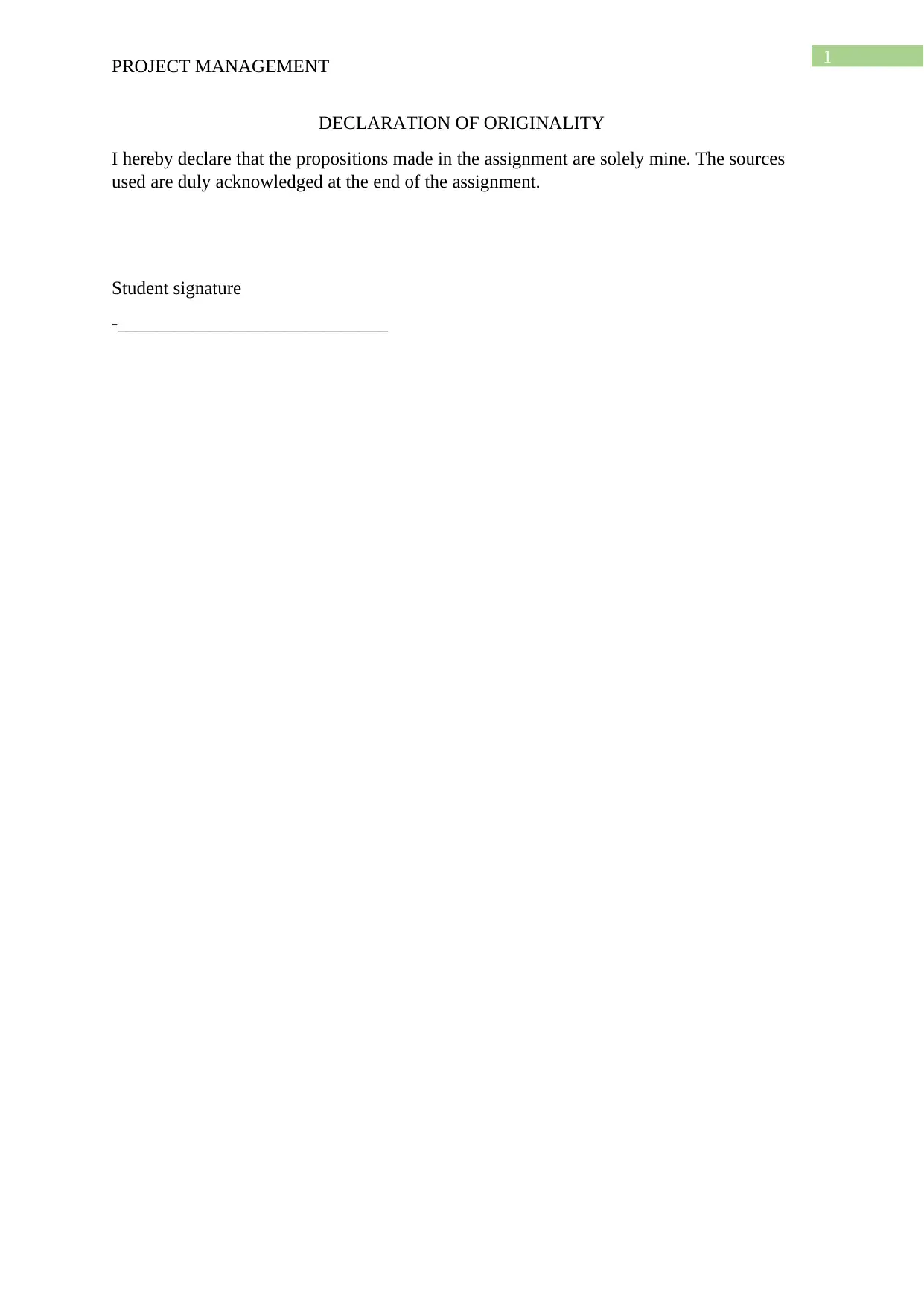
1
PROJECT MANAGEMENT
DECLARATION OF ORIGINALITY
I hereby declare that the propositions made in the assignment are solely mine. The sources
used are duly acknowledged at the end of the assignment.
Student signature
-_____________________________
PROJECT MANAGEMENT
DECLARATION OF ORIGINALITY
I hereby declare that the propositions made in the assignment are solely mine. The sources
used are duly acknowledged at the end of the assignment.
Student signature
-_____________________________
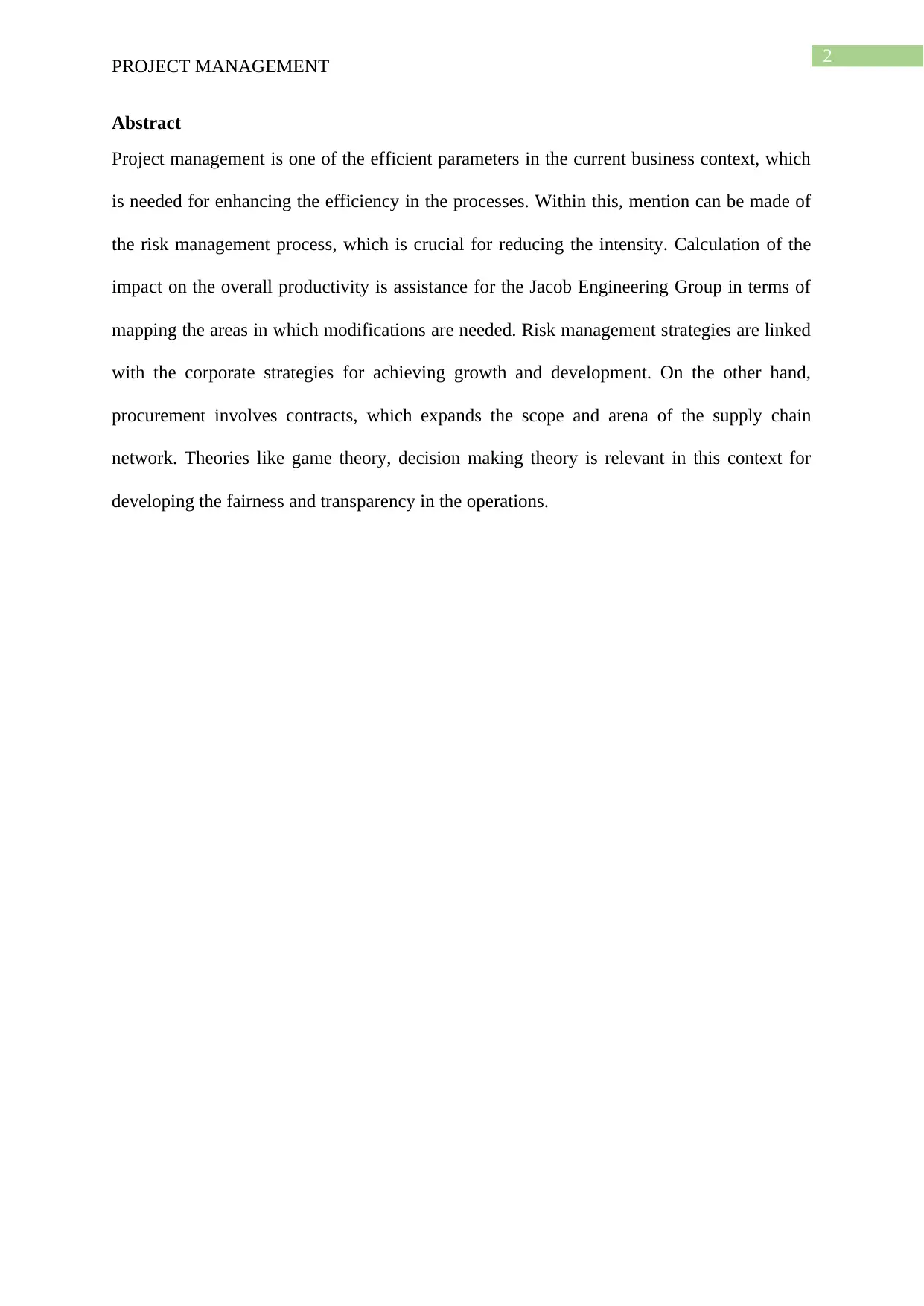
2
PROJECT MANAGEMENT
Abstract
Project management is one of the efficient parameters in the current business context, which
is needed for enhancing the efficiency in the processes. Within this, mention can be made of
the risk management process, which is crucial for reducing the intensity. Calculation of the
impact on the overall productivity is assistance for the Jacob Engineering Group in terms of
mapping the areas in which modifications are needed. Risk management strategies are linked
with the corporate strategies for achieving growth and development. On the other hand,
procurement involves contracts, which expands the scope and arena of the supply chain
network. Theories like game theory, decision making theory is relevant in this context for
developing the fairness and transparency in the operations.
PROJECT MANAGEMENT
Abstract
Project management is one of the efficient parameters in the current business context, which
is needed for enhancing the efficiency in the processes. Within this, mention can be made of
the risk management process, which is crucial for reducing the intensity. Calculation of the
impact on the overall productivity is assistance for the Jacob Engineering Group in terms of
mapping the areas in which modifications are needed. Risk management strategies are linked
with the corporate strategies for achieving growth and development. On the other hand,
procurement involves contracts, which expands the scope and arena of the supply chain
network. Theories like game theory, decision making theory is relevant in this context for
developing the fairness and transparency in the operations.
⊘ This is a preview!⊘
Do you want full access?
Subscribe today to unlock all pages.

Trusted by 1+ million students worldwide
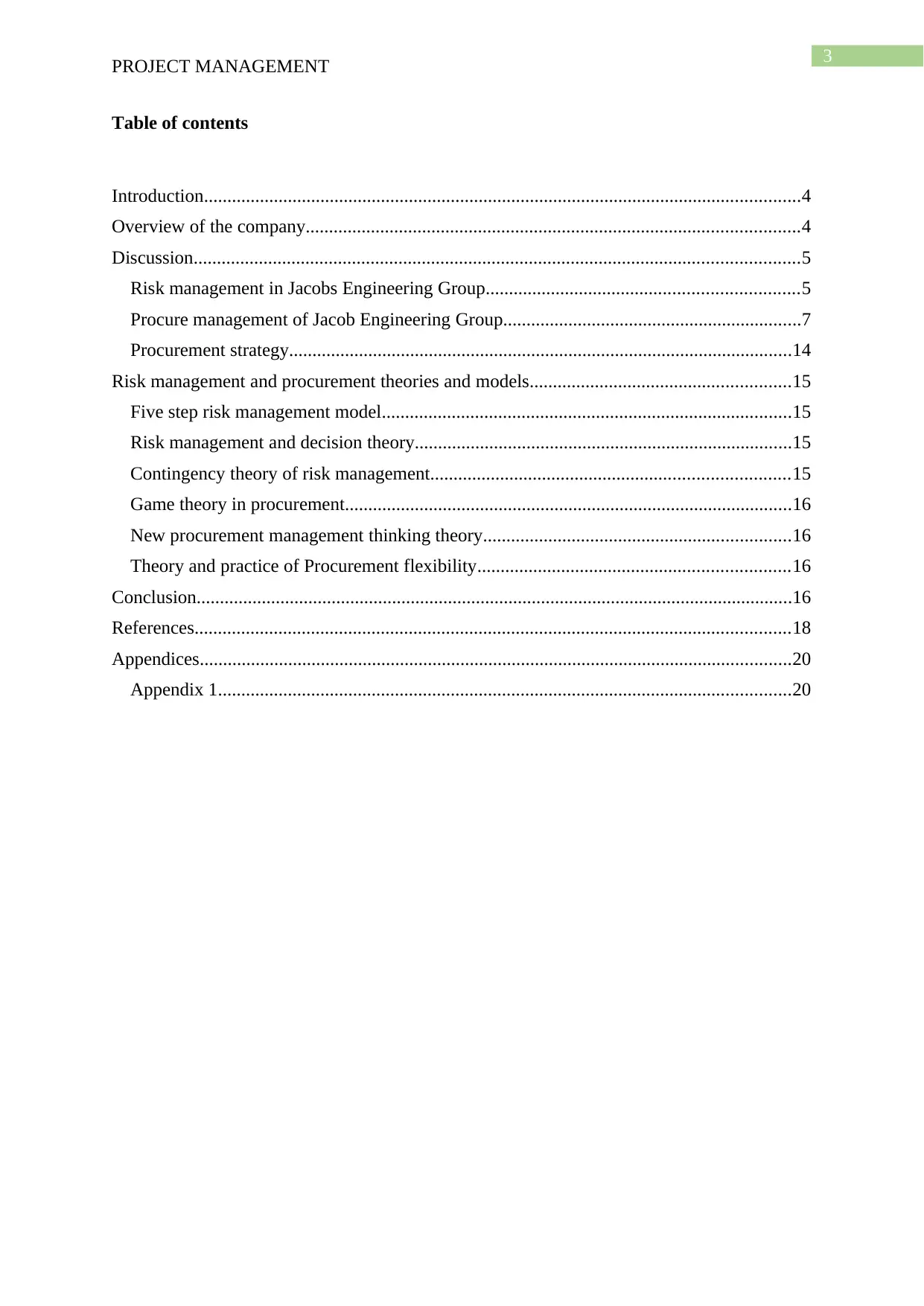
3
PROJECT MANAGEMENT
Table of contents
Introduction................................................................................................................................4
Overview of the company..........................................................................................................4
Discussion..................................................................................................................................5
Risk management in Jacobs Engineering Group...................................................................5
Procure management of Jacob Engineering Group................................................................7
Procurement strategy............................................................................................................14
Risk management and procurement theories and models........................................................15
Five step risk management model........................................................................................15
Risk management and decision theory.................................................................................15
Contingency theory of risk management.............................................................................15
Game theory in procurement................................................................................................16
New procurement management thinking theory..................................................................16
Theory and practice of Procurement flexibility...................................................................16
Conclusion................................................................................................................................16
References................................................................................................................................18
Appendices...............................................................................................................................20
Appendix 1...........................................................................................................................20
PROJECT MANAGEMENT
Table of contents
Introduction................................................................................................................................4
Overview of the company..........................................................................................................4
Discussion..................................................................................................................................5
Risk management in Jacobs Engineering Group...................................................................5
Procure management of Jacob Engineering Group................................................................7
Procurement strategy............................................................................................................14
Risk management and procurement theories and models........................................................15
Five step risk management model........................................................................................15
Risk management and decision theory.................................................................................15
Contingency theory of risk management.............................................................................15
Game theory in procurement................................................................................................16
New procurement management thinking theory..................................................................16
Theory and practice of Procurement flexibility...................................................................16
Conclusion................................................................................................................................16
References................................................................................................................................18
Appendices...............................................................................................................................20
Appendix 1...........................................................................................................................20
Paraphrase This Document
Need a fresh take? Get an instant paraphrase of this document with our AI Paraphraser
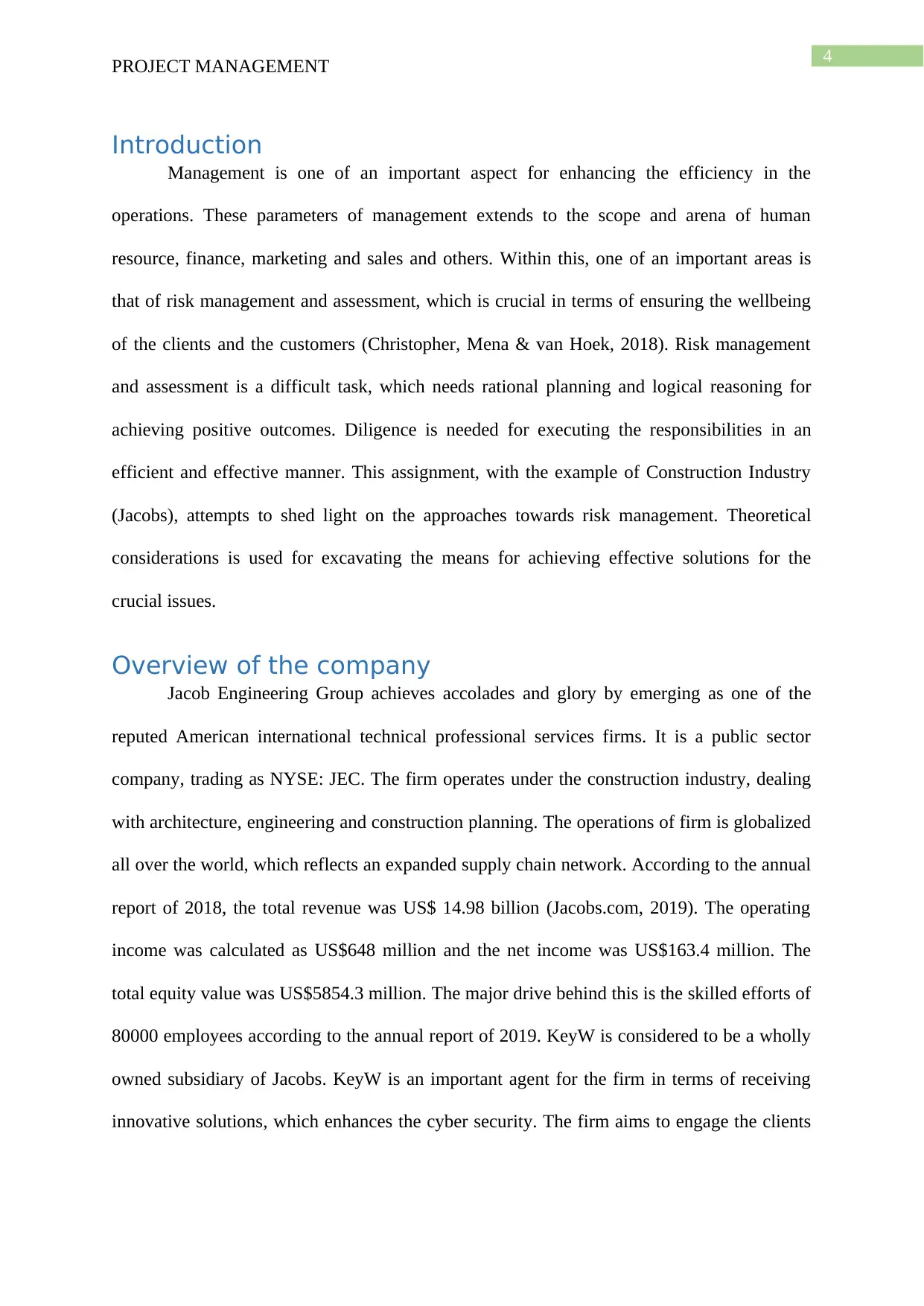
4
PROJECT MANAGEMENT
Introduction
Management is one of an important aspect for enhancing the efficiency in the
operations. These parameters of management extends to the scope and arena of human
resource, finance, marketing and sales and others. Within this, one of an important areas is
that of risk management and assessment, which is crucial in terms of ensuring the wellbeing
of the clients and the customers (Christopher, Mena & van Hoek, 2018). Risk management
and assessment is a difficult task, which needs rational planning and logical reasoning for
achieving positive outcomes. Diligence is needed for executing the responsibilities in an
efficient and effective manner. This assignment, with the example of Construction Industry
(Jacobs), attempts to shed light on the approaches towards risk management. Theoretical
considerations is used for excavating the means for achieving effective solutions for the
crucial issues.
Overview of the company
Jacob Engineering Group achieves accolades and glory by emerging as one of the
reputed American international technical professional services firms. It is a public sector
company, trading as NYSE: JEC. The firm operates under the construction industry, dealing
with architecture, engineering and construction planning. The operations of firm is globalized
all over the world, which reflects an expanded supply chain network. According to the annual
report of 2018, the total revenue was US$ 14.98 billion (Jacobs.com, 2019). The operating
income was calculated as US$648 million and the net income was US$163.4 million. The
total equity value was US$5854.3 million. The major drive behind this is the skilled efforts of
80000 employees according to the annual report of 2019. KeyW is considered to be a wholly
owned subsidiary of Jacobs. KeyW is an important agent for the firm in terms of receiving
innovative solutions, which enhances the cyber security. The firm aims to engage the clients
PROJECT MANAGEMENT
Introduction
Management is one of an important aspect for enhancing the efficiency in the
operations. These parameters of management extends to the scope and arena of human
resource, finance, marketing and sales and others. Within this, one of an important areas is
that of risk management and assessment, which is crucial in terms of ensuring the wellbeing
of the clients and the customers (Christopher, Mena & van Hoek, 2018). Risk management
and assessment is a difficult task, which needs rational planning and logical reasoning for
achieving positive outcomes. Diligence is needed for executing the responsibilities in an
efficient and effective manner. This assignment, with the example of Construction Industry
(Jacobs), attempts to shed light on the approaches towards risk management. Theoretical
considerations is used for excavating the means for achieving effective solutions for the
crucial issues.
Overview of the company
Jacob Engineering Group achieves accolades and glory by emerging as one of the
reputed American international technical professional services firms. It is a public sector
company, trading as NYSE: JEC. The firm operates under the construction industry, dealing
with architecture, engineering and construction planning. The operations of firm is globalized
all over the world, which reflects an expanded supply chain network. According to the annual
report of 2018, the total revenue was US$ 14.98 billion (Jacobs.com, 2019). The operating
income was calculated as US$648 million and the net income was US$163.4 million. The
total equity value was US$5854.3 million. The major drive behind this is the skilled efforts of
80000 employees according to the annual report of 2019. KeyW is considered to be a wholly
owned subsidiary of Jacobs. KeyW is an important agent for the firm in terms of receiving
innovative solutions, which enhances the cyber security. The firm aims to engage the clients
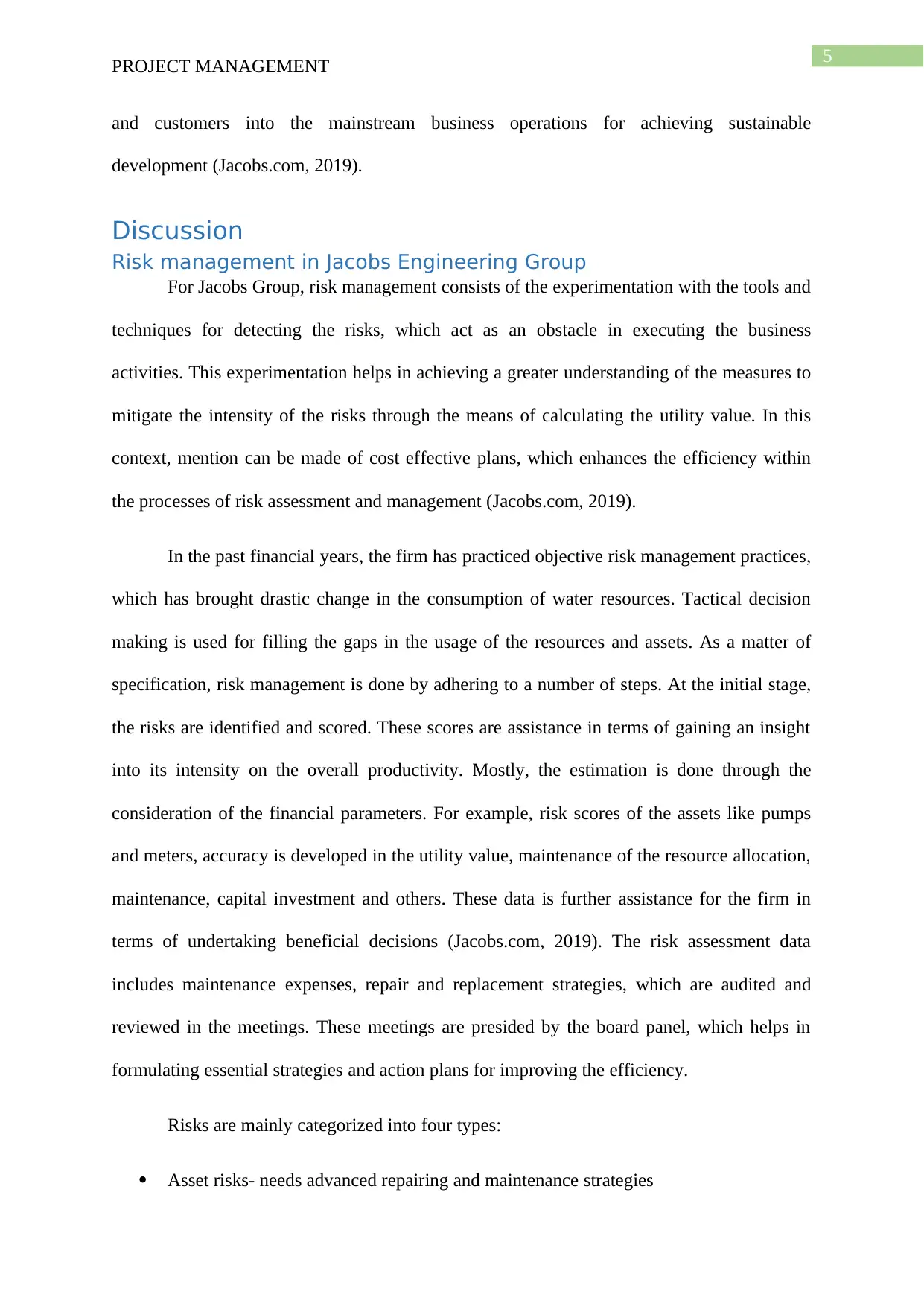
5
PROJECT MANAGEMENT
and customers into the mainstream business operations for achieving sustainable
development (Jacobs.com, 2019).
Discussion
Risk management in Jacobs Engineering Group
For Jacobs Group, risk management consists of the experimentation with the tools and
techniques for detecting the risks, which act as an obstacle in executing the business
activities. This experimentation helps in achieving a greater understanding of the measures to
mitigate the intensity of the risks through the means of calculating the utility value. In this
context, mention can be made of cost effective plans, which enhances the efficiency within
the processes of risk assessment and management (Jacobs.com, 2019).
In the past financial years, the firm has practiced objective risk management practices,
which has brought drastic change in the consumption of water resources. Tactical decision
making is used for filling the gaps in the usage of the resources and assets. As a matter of
specification, risk management is done by adhering to a number of steps. At the initial stage,
the risks are identified and scored. These scores are assistance in terms of gaining an insight
into its intensity on the overall productivity. Mostly, the estimation is done through the
consideration of the financial parameters. For example, risk scores of the assets like pumps
and meters, accuracy is developed in the utility value, maintenance of the resource allocation,
maintenance, capital investment and others. These data is further assistance for the firm in
terms of undertaking beneficial decisions (Jacobs.com, 2019). The risk assessment data
includes maintenance expenses, repair and replacement strategies, which are audited and
reviewed in the meetings. These meetings are presided by the board panel, which helps in
formulating essential strategies and action plans for improving the efficiency.
Risks are mainly categorized into four types:
Asset risks- needs advanced repairing and maintenance strategies
PROJECT MANAGEMENT
and customers into the mainstream business operations for achieving sustainable
development (Jacobs.com, 2019).
Discussion
Risk management in Jacobs Engineering Group
For Jacobs Group, risk management consists of the experimentation with the tools and
techniques for detecting the risks, which act as an obstacle in executing the business
activities. This experimentation helps in achieving a greater understanding of the measures to
mitigate the intensity of the risks through the means of calculating the utility value. In this
context, mention can be made of cost effective plans, which enhances the efficiency within
the processes of risk assessment and management (Jacobs.com, 2019).
In the past financial years, the firm has practiced objective risk management practices,
which has brought drastic change in the consumption of water resources. Tactical decision
making is used for filling the gaps in the usage of the resources and assets. As a matter of
specification, risk management is done by adhering to a number of steps. At the initial stage,
the risks are identified and scored. These scores are assistance in terms of gaining an insight
into its intensity on the overall productivity. Mostly, the estimation is done through the
consideration of the financial parameters. For example, risk scores of the assets like pumps
and meters, accuracy is developed in the utility value, maintenance of the resource allocation,
maintenance, capital investment and others. These data is further assistance for the firm in
terms of undertaking beneficial decisions (Jacobs.com, 2019). The risk assessment data
includes maintenance expenses, repair and replacement strategies, which are audited and
reviewed in the meetings. These meetings are presided by the board panel, which helps in
formulating essential strategies and action plans for improving the efficiency.
Risks are mainly categorized into four types:
Asset risks- needs advanced repairing and maintenance strategies
⊘ This is a preview!⊘
Do you want full access?
Subscribe today to unlock all pages.

Trusted by 1+ million students worldwide
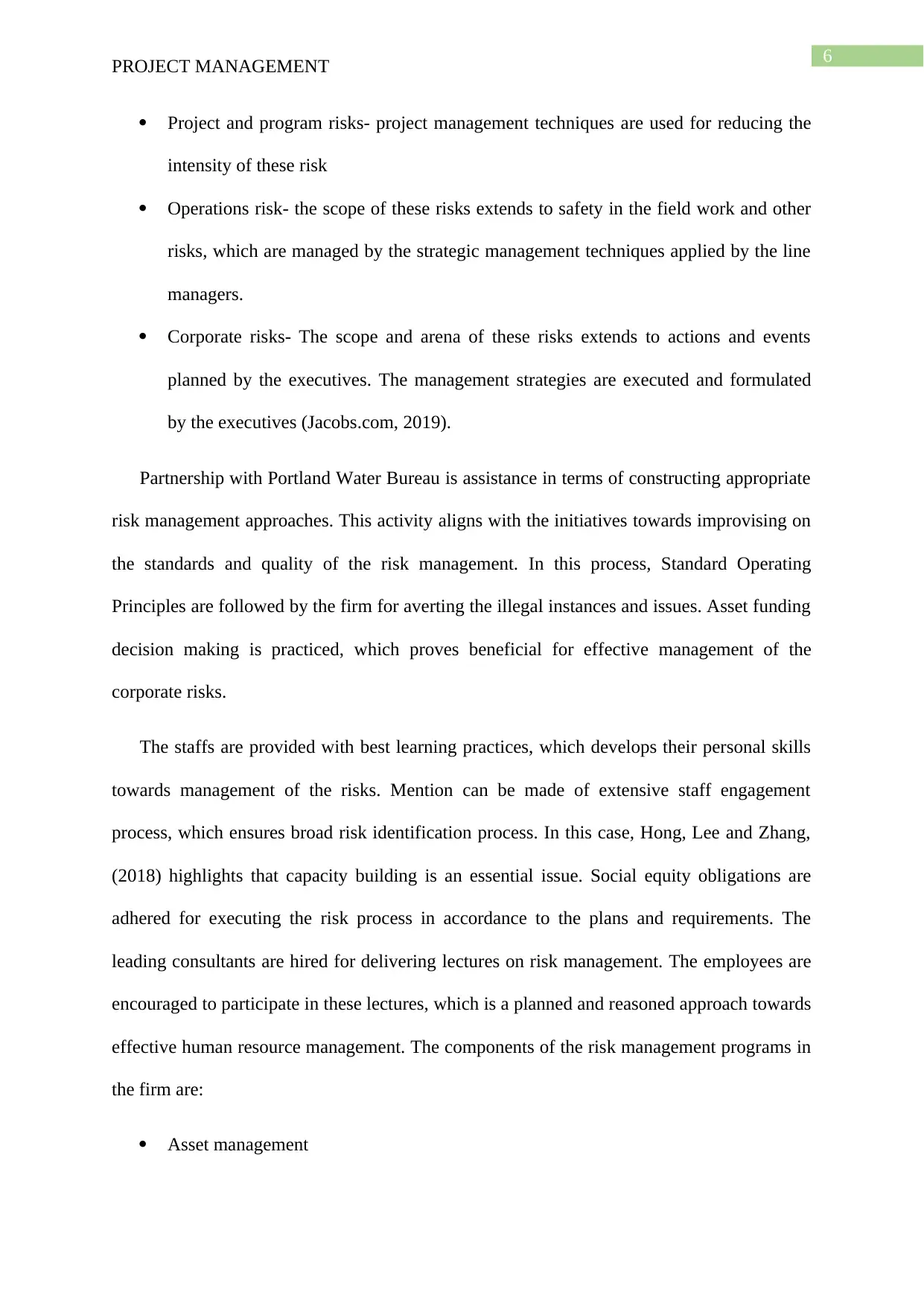
6
PROJECT MANAGEMENT
Project and program risks- project management techniques are used for reducing the
intensity of these risk
Operations risk- the scope of these risks extends to safety in the field work and other
risks, which are managed by the strategic management techniques applied by the line
managers.
Corporate risks- The scope and arena of these risks extends to actions and events
planned by the executives. The management strategies are executed and formulated
by the executives (Jacobs.com, 2019).
Partnership with Portland Water Bureau is assistance in terms of constructing appropriate
risk management approaches. This activity aligns with the initiatives towards improvising on
the standards and quality of the risk management. In this process, Standard Operating
Principles are followed by the firm for averting the illegal instances and issues. Asset funding
decision making is practiced, which proves beneficial for effective management of the
corporate risks.
The staffs are provided with best learning practices, which develops their personal skills
towards management of the risks. Mention can be made of extensive staff engagement
process, which ensures broad risk identification process. In this case, Hong, Lee and Zhang,
(2018) highlights that capacity building is an essential issue. Social equity obligations are
adhered for executing the risk process in accordance to the plans and requirements. The
leading consultants are hired for delivering lectures on risk management. The employees are
encouraged to participate in these lectures, which is a planned and reasoned approach towards
effective human resource management. The components of the risk management programs in
the firm are:
Asset management
PROJECT MANAGEMENT
Project and program risks- project management techniques are used for reducing the
intensity of these risk
Operations risk- the scope of these risks extends to safety in the field work and other
risks, which are managed by the strategic management techniques applied by the line
managers.
Corporate risks- The scope and arena of these risks extends to actions and events
planned by the executives. The management strategies are executed and formulated
by the executives (Jacobs.com, 2019).
Partnership with Portland Water Bureau is assistance in terms of constructing appropriate
risk management approaches. This activity aligns with the initiatives towards improvising on
the standards and quality of the risk management. In this process, Standard Operating
Principles are followed by the firm for averting the illegal instances and issues. Asset funding
decision making is practiced, which proves beneficial for effective management of the
corporate risks.
The staffs are provided with best learning practices, which develops their personal skills
towards management of the risks. Mention can be made of extensive staff engagement
process, which ensures broad risk identification process. In this case, Hong, Lee and Zhang,
(2018) highlights that capacity building is an essential issue. Social equity obligations are
adhered for executing the risk process in accordance to the plans and requirements. The
leading consultants are hired for delivering lectures on risk management. The employees are
encouraged to participate in these lectures, which is a planned and reasoned approach towards
effective human resource management. The components of the risk management programs in
the firm are:
Asset management
Paraphrase This Document
Need a fresh take? Get an instant paraphrase of this document with our AI Paraphraser
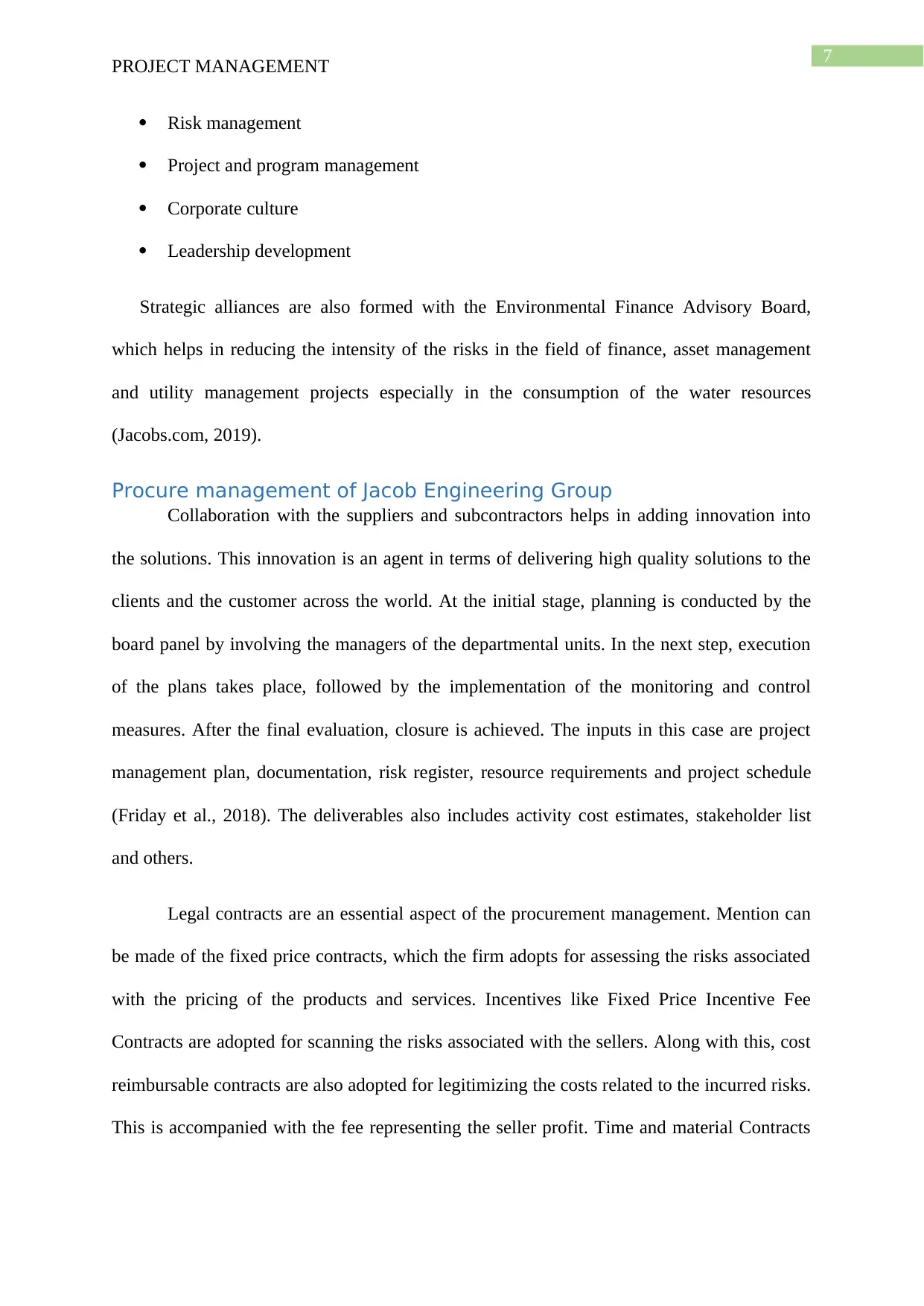
7
PROJECT MANAGEMENT
Risk management
Project and program management
Corporate culture
Leadership development
Strategic alliances are also formed with the Environmental Finance Advisory Board,
which helps in reducing the intensity of the risks in the field of finance, asset management
and utility management projects especially in the consumption of the water resources
(Jacobs.com, 2019).
Procure management of Jacob Engineering Group
Collaboration with the suppliers and subcontractors helps in adding innovation into
the solutions. This innovation is an agent in terms of delivering high quality solutions to the
clients and the customer across the world. At the initial stage, planning is conducted by the
board panel by involving the managers of the departmental units. In the next step, execution
of the plans takes place, followed by the implementation of the monitoring and control
measures. After the final evaluation, closure is achieved. The inputs in this case are project
management plan, documentation, risk register, resource requirements and project schedule
(Friday et al., 2018). The deliverables also includes activity cost estimates, stakeholder list
and others.
Legal contracts are an essential aspect of the procurement management. Mention can
be made of the fixed price contracts, which the firm adopts for assessing the risks associated
with the pricing of the products and services. Incentives like Fixed Price Incentive Fee
Contracts are adopted for scanning the risks associated with the sellers. Along with this, cost
reimbursable contracts are also adopted for legitimizing the costs related to the incurred risks.
This is accompanied with the fee representing the seller profit. Time and material Contracts
PROJECT MANAGEMENT
Risk management
Project and program management
Corporate culture
Leadership development
Strategic alliances are also formed with the Environmental Finance Advisory Board,
which helps in reducing the intensity of the risks in the field of finance, asset management
and utility management projects especially in the consumption of the water resources
(Jacobs.com, 2019).
Procure management of Jacob Engineering Group
Collaboration with the suppliers and subcontractors helps in adding innovation into
the solutions. This innovation is an agent in terms of delivering high quality solutions to the
clients and the customer across the world. At the initial stage, planning is conducted by the
board panel by involving the managers of the departmental units. In the next step, execution
of the plans takes place, followed by the implementation of the monitoring and control
measures. After the final evaluation, closure is achieved. The inputs in this case are project
management plan, documentation, risk register, resource requirements and project schedule
(Friday et al., 2018). The deliverables also includes activity cost estimates, stakeholder list
and others.
Legal contracts are an essential aspect of the procurement management. Mention can
be made of the fixed price contracts, which the firm adopts for assessing the risks associated
with the pricing of the products and services. Incentives like Fixed Price Incentive Fee
Contracts are adopted for scanning the risks associated with the sellers. Along with this, cost
reimbursable contracts are also adopted for legitimizing the costs related to the incurred risks.
This is accompanied with the fee representing the seller profit. Time and material Contracts
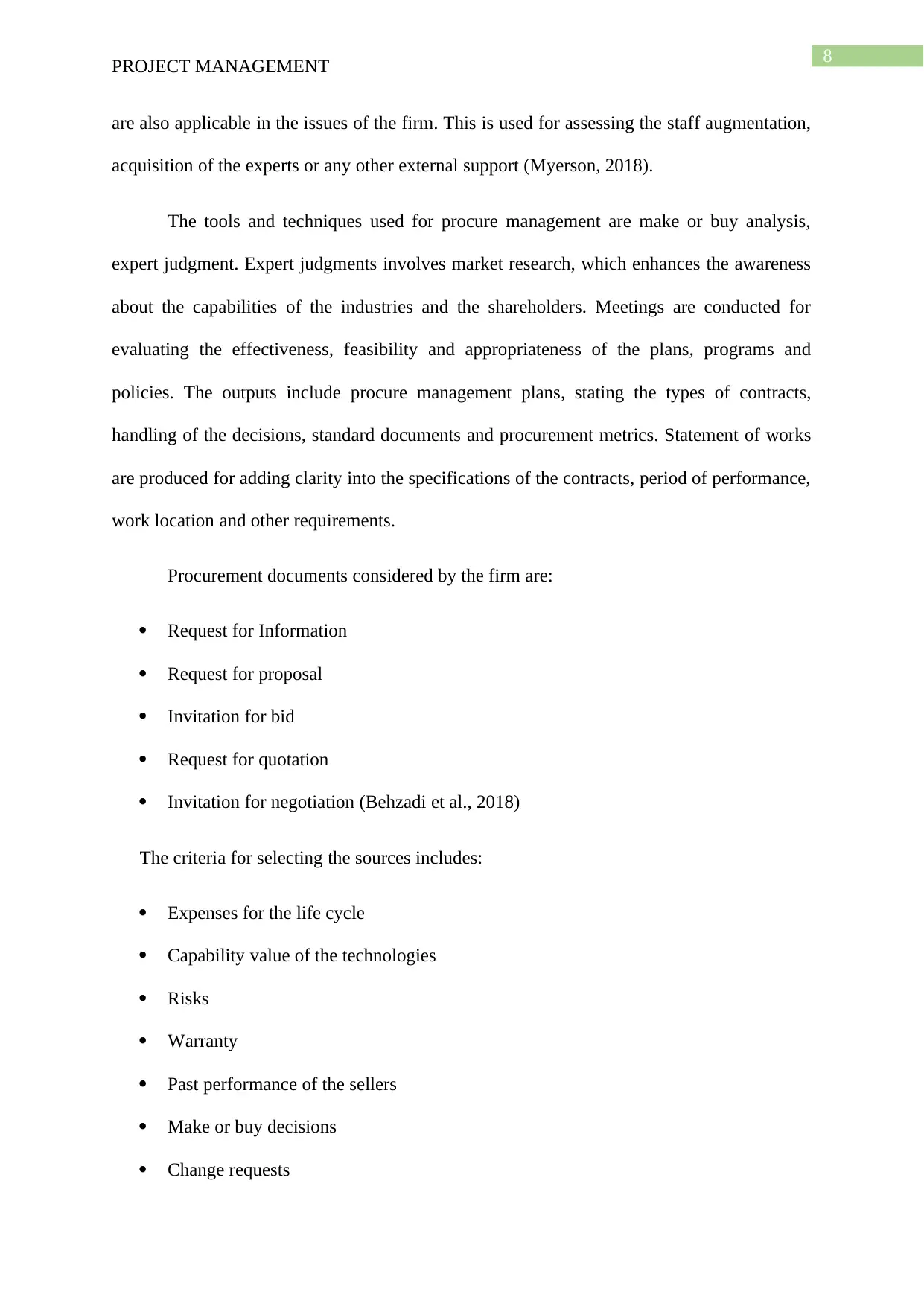
8
PROJECT MANAGEMENT
are also applicable in the issues of the firm. This is used for assessing the staff augmentation,
acquisition of the experts or any other external support (Myerson, 2018).
The tools and techniques used for procure management are make or buy analysis,
expert judgment. Expert judgments involves market research, which enhances the awareness
about the capabilities of the industries and the shareholders. Meetings are conducted for
evaluating the effectiveness, feasibility and appropriateness of the plans, programs and
policies. The outputs include procure management plans, stating the types of contracts,
handling of the decisions, standard documents and procurement metrics. Statement of works
are produced for adding clarity into the specifications of the contracts, period of performance,
work location and other requirements.
Procurement documents considered by the firm are:
Request for Information
Request for proposal
Invitation for bid
Request for quotation
Invitation for negotiation (Behzadi et al., 2018)
The criteria for selecting the sources includes:
Expenses for the life cycle
Capability value of the technologies
Risks
Warranty
Past performance of the sellers
Make or buy decisions
Change requests
PROJECT MANAGEMENT
are also applicable in the issues of the firm. This is used for assessing the staff augmentation,
acquisition of the experts or any other external support (Myerson, 2018).
The tools and techniques used for procure management are make or buy analysis,
expert judgment. Expert judgments involves market research, which enhances the awareness
about the capabilities of the industries and the shareholders. Meetings are conducted for
evaluating the effectiveness, feasibility and appropriateness of the plans, programs and
policies. The outputs include procure management plans, stating the types of contracts,
handling of the decisions, standard documents and procurement metrics. Statement of works
are produced for adding clarity into the specifications of the contracts, period of performance,
work location and other requirements.
Procurement documents considered by the firm are:
Request for Information
Request for proposal
Invitation for bid
Request for quotation
Invitation for negotiation (Behzadi et al., 2018)
The criteria for selecting the sources includes:
Expenses for the life cycle
Capability value of the technologies
Risks
Warranty
Past performance of the sellers
Make or buy decisions
Change requests
⊘ This is a preview!⊘
Do you want full access?
Subscribe today to unlock all pages.

Trusted by 1+ million students worldwide
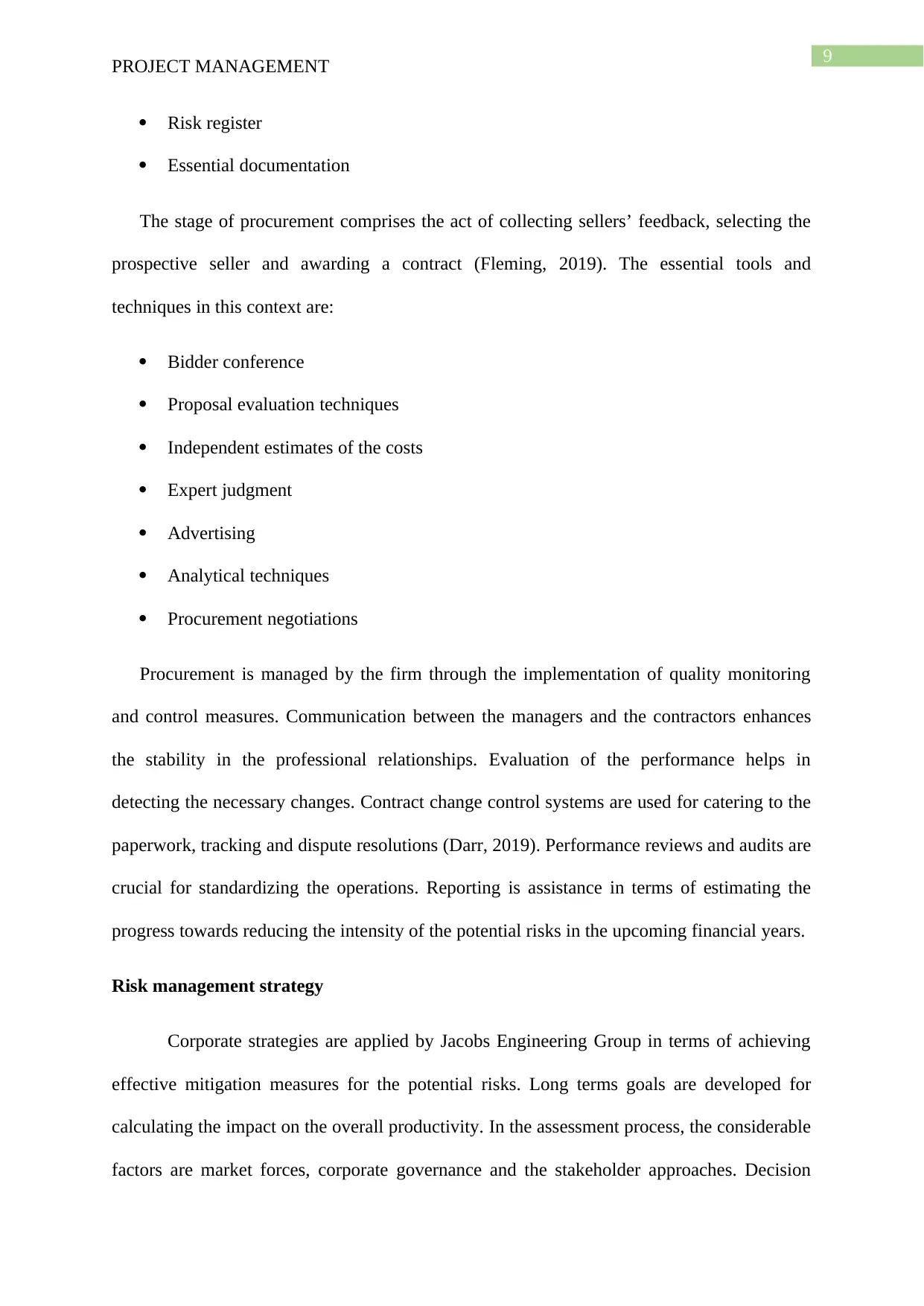
9
PROJECT MANAGEMENT
Risk register
Essential documentation
The stage of procurement comprises the act of collecting sellers’ feedback, selecting the
prospective seller and awarding a contract (Fleming, 2019). The essential tools and
techniques in this context are:
Bidder conference
Proposal evaluation techniques
Independent estimates of the costs
Expert judgment
Advertising
Analytical techniques
Procurement negotiations
Procurement is managed by the firm through the implementation of quality monitoring
and control measures. Communication between the managers and the contractors enhances
the stability in the professional relationships. Evaluation of the performance helps in
detecting the necessary changes. Contract change control systems are used for catering to the
paperwork, tracking and dispute resolutions (Darr, 2019). Performance reviews and audits are
crucial for standardizing the operations. Reporting is assistance in terms of estimating the
progress towards reducing the intensity of the potential risks in the upcoming financial years.
Risk management strategy
Corporate strategies are applied by Jacobs Engineering Group in terms of achieving
effective mitigation measures for the potential risks. Long terms goals are developed for
calculating the impact on the overall productivity. In the assessment process, the considerable
factors are market forces, corporate governance and the stakeholder approaches. Decision
PROJECT MANAGEMENT
Risk register
Essential documentation
The stage of procurement comprises the act of collecting sellers’ feedback, selecting the
prospective seller and awarding a contract (Fleming, 2019). The essential tools and
techniques in this context are:
Bidder conference
Proposal evaluation techniques
Independent estimates of the costs
Expert judgment
Advertising
Analytical techniques
Procurement negotiations
Procurement is managed by the firm through the implementation of quality monitoring
and control measures. Communication between the managers and the contractors enhances
the stability in the professional relationships. Evaluation of the performance helps in
detecting the necessary changes. Contract change control systems are used for catering to the
paperwork, tracking and dispute resolutions (Darr, 2019). Performance reviews and audits are
crucial for standardizing the operations. Reporting is assistance in terms of estimating the
progress towards reducing the intensity of the potential risks in the upcoming financial years.
Risk management strategy
Corporate strategies are applied by Jacobs Engineering Group in terms of achieving
effective mitigation measures for the potential risks. Long terms goals are developed for
calculating the impact on the overall productivity. In the assessment process, the considerable
factors are market forces, corporate governance and the stakeholder approaches. Decision
Paraphrase This Document
Need a fresh take? Get an instant paraphrase of this document with our AI Paraphraser
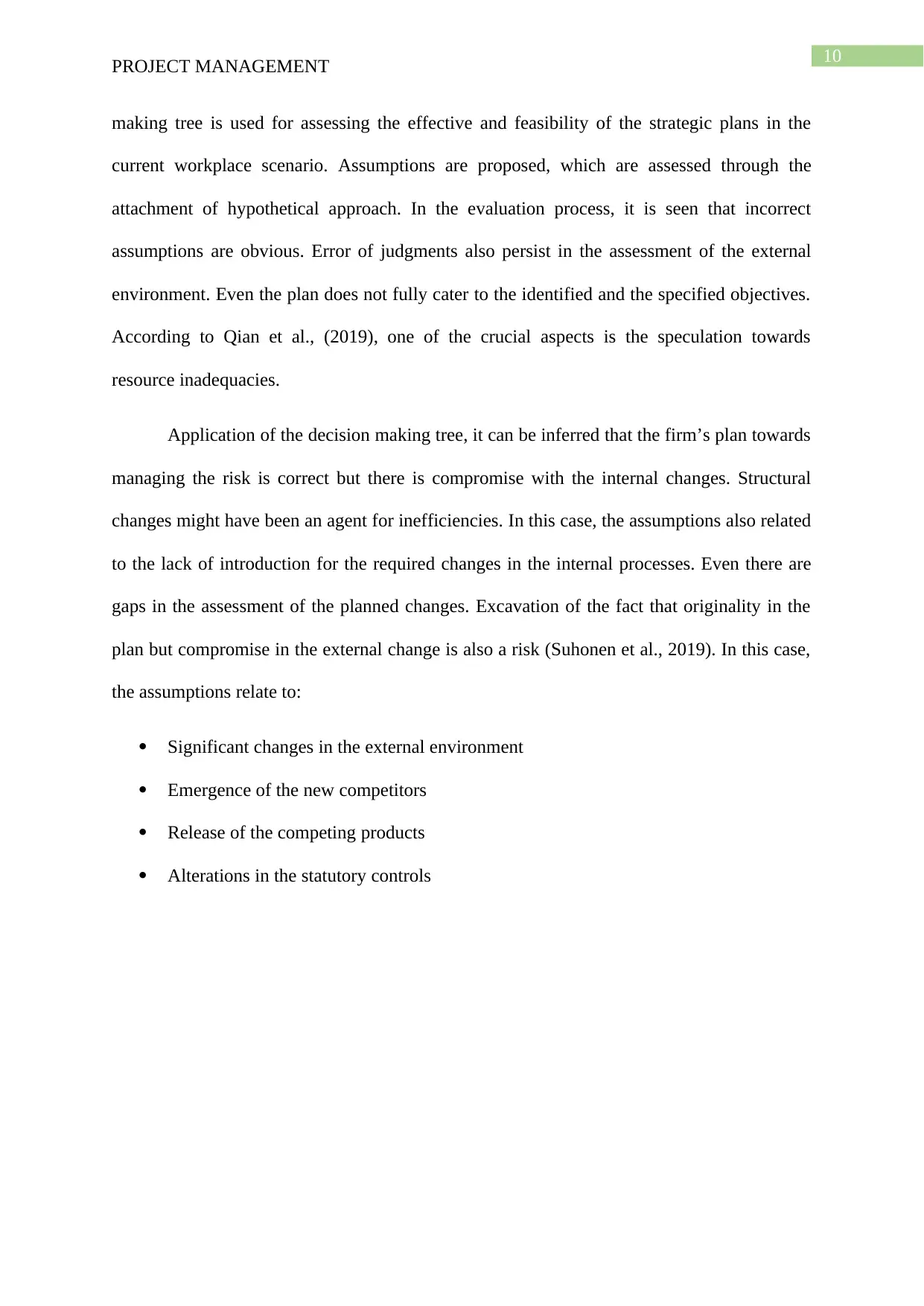
10
PROJECT MANAGEMENT
making tree is used for assessing the effective and feasibility of the strategic plans in the
current workplace scenario. Assumptions are proposed, which are assessed through the
attachment of hypothetical approach. In the evaluation process, it is seen that incorrect
assumptions are obvious. Error of judgments also persist in the assessment of the external
environment. Even the plan does not fully cater to the identified and the specified objectives.
According to Qian et al., (2019), one of the crucial aspects is the speculation towards
resource inadequacies.
Application of the decision making tree, it can be inferred that the firm’s plan towards
managing the risk is correct but there is compromise with the internal changes. Structural
changes might have been an agent for inefficiencies. In this case, the assumptions also related
to the lack of introduction for the required changes in the internal processes. Even there are
gaps in the assessment of the planned changes. Excavation of the fact that originality in the
plan but compromise in the external change is also a risk (Suhonen et al., 2019). In this case,
the assumptions relate to:
Significant changes in the external environment
Emergence of the new competitors
Release of the competing products
Alterations in the statutory controls
PROJECT MANAGEMENT
making tree is used for assessing the effective and feasibility of the strategic plans in the
current workplace scenario. Assumptions are proposed, which are assessed through the
attachment of hypothetical approach. In the evaluation process, it is seen that incorrect
assumptions are obvious. Error of judgments also persist in the assessment of the external
environment. Even the plan does not fully cater to the identified and the specified objectives.
According to Qian et al., (2019), one of the crucial aspects is the speculation towards
resource inadequacies.
Application of the decision making tree, it can be inferred that the firm’s plan towards
managing the risk is correct but there is compromise with the internal changes. Structural
changes might have been an agent for inefficiencies. In this case, the assumptions also related
to the lack of introduction for the required changes in the internal processes. Even there are
gaps in the assessment of the planned changes. Excavation of the fact that originality in the
plan but compromise in the external change is also a risk (Suhonen et al., 2019). In this case,
the assumptions relate to:
Significant changes in the external environment
Emergence of the new competitors
Release of the competing products
Alterations in the statutory controls
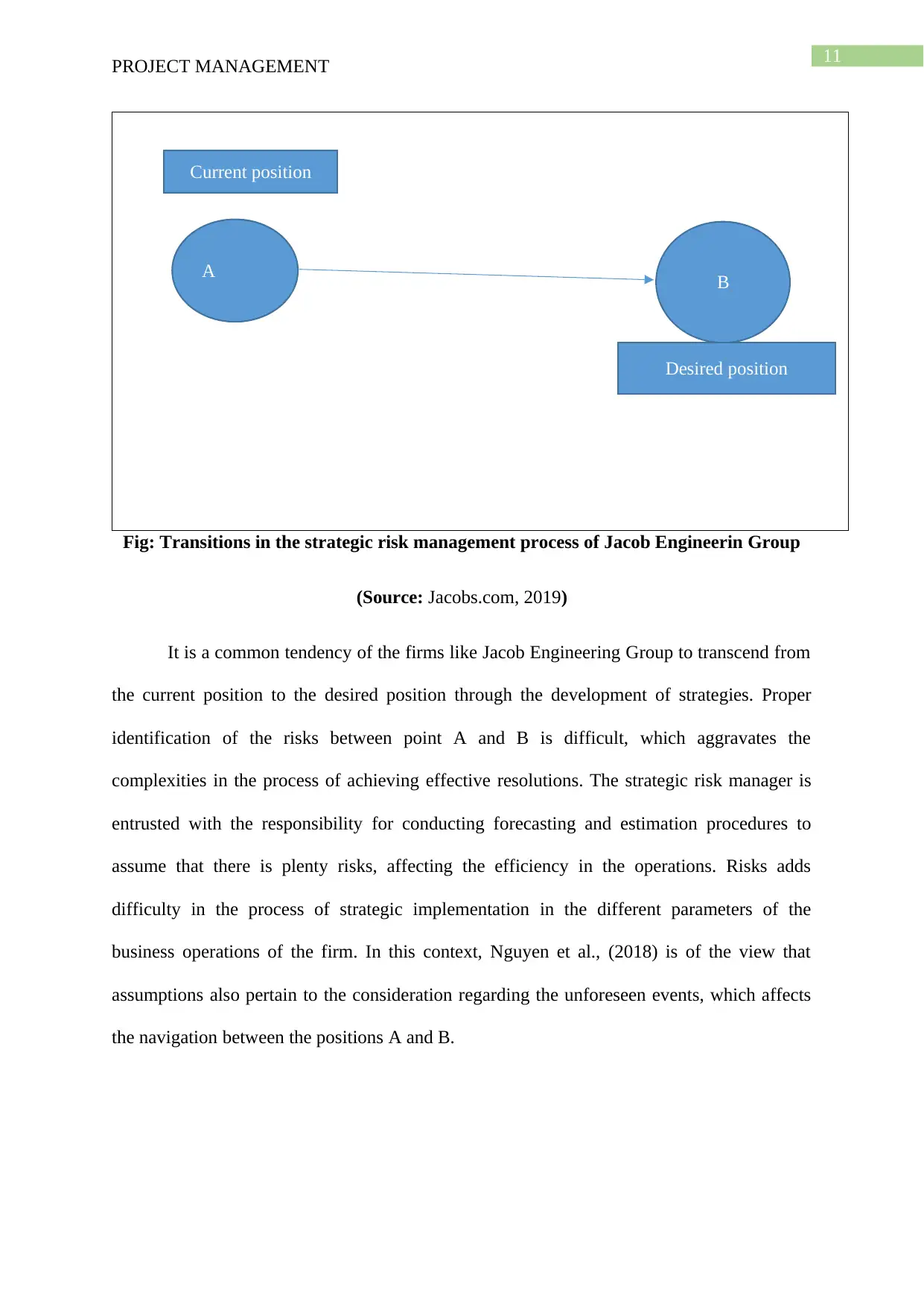
11
PROJECT MANAGEMENT
Fig: Transitions in the strategic risk management process of Jacob Engineerin Group
(Source: Jacobs.com, 2019)
It is a common tendency of the firms like Jacob Engineering Group to transcend from
the current position to the desired position through the development of strategies. Proper
identification of the risks between point A and B is difficult, which aggravates the
complexities in the process of achieving effective resolutions. The strategic risk manager is
entrusted with the responsibility for conducting forecasting and estimation procedures to
assume that there is plenty risks, affecting the efficiency in the operations. Risks adds
difficulty in the process of strategic implementation in the different parameters of the
business operations of the firm. In this context, Nguyen et al., (2018) is of the view that
assumptions also pertain to the consideration regarding the unforeseen events, which affects
the navigation between the positions A and B.
A B
Current position
Desired position
PROJECT MANAGEMENT
Fig: Transitions in the strategic risk management process of Jacob Engineerin Group
(Source: Jacobs.com, 2019)
It is a common tendency of the firms like Jacob Engineering Group to transcend from
the current position to the desired position through the development of strategies. Proper
identification of the risks between point A and B is difficult, which aggravates the
complexities in the process of achieving effective resolutions. The strategic risk manager is
entrusted with the responsibility for conducting forecasting and estimation procedures to
assume that there is plenty risks, affecting the efficiency in the operations. Risks adds
difficulty in the process of strategic implementation in the different parameters of the
business operations of the firm. In this context, Nguyen et al., (2018) is of the view that
assumptions also pertain to the consideration regarding the unforeseen events, which affects
the navigation between the positions A and B.
A B
Current position
Desired position
⊘ This is a preview!⊘
Do you want full access?
Subscribe today to unlock all pages.

Trusted by 1+ million students worldwide
1 out of 23
Related Documents
Your All-in-One AI-Powered Toolkit for Academic Success.
+13062052269
info@desklib.com
Available 24*7 on WhatsApp / Email
![[object Object]](/_next/static/media/star-bottom.7253800d.svg)
Unlock your academic potential
Copyright © 2020–2025 A2Z Services. All Rights Reserved. Developed and managed by ZUCOL.




